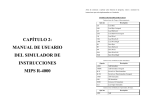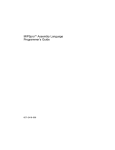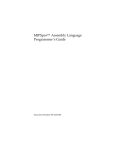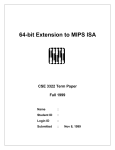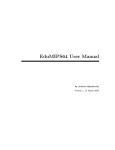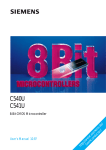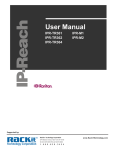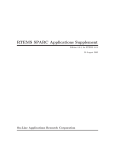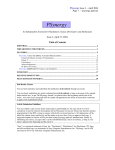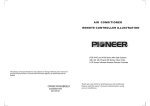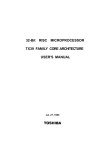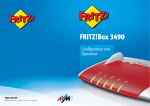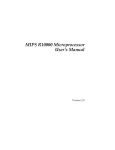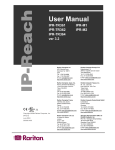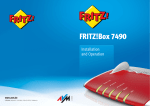Download 5. The Instruction Set
Transcript
Chapter 5 5. The Instruction Set This chapter describes instruction notation and discusses assembler instructions for the main processor. Chapter 6 describes coprocessor notation and instructions. Instruction Classes The assembler has these classes of instructions for the main processor: • Load and Store Instructions. These instructions load immediate values and move data between memory and general registers. • Computational Instructions. These instructions do arithmetic and logical operations for values in registers. • Jump and Branch Instructions. These instructions change program control flow. In addition, there are two other classes of instruction: • Coprocessor Interface. These instructions provide standard interfaces to the coprocessors. • Special Instructions. These instructions do miscellaneous tasks. Reorganization Constraints and Rules To maximize performance, the goal of RISC designs is to achieve an execution rate of one machine cycle per instruction. When writing assembly language instructions, you must be aware of the rules to achieve this goal. This information is given in the MIPS R4000 Microprocessor User’s Manual (published by Prentice Hall) or the MIPS R8000 Microprocessor User’s Manual, depending on which architecture you are using. 27 Chapter 5: The Instruction Set Instruction Notation The tables in this chapter list the assembler format for each load, store, computational, jump, branch, coprocessor, and special instruction. The format consists of an op-code and a list of operand formats. The tables list groups of closely related instructions; for those instructions, you can use any op-code with any specified operand. Operands can take any of these formats: • Memory references. For example, a relocatable symbol +/– an expression(register). • Expressions (for immediate values). • Two or three operands. For example, ADD $3,$4 is the same as ADD $3,$3,$4. The operands in the table in this chapter have the following meanings 28 Operand Description address Symbolic expression (see Chapter2) breakcode Value that determines the break destination Destination register destination/src1 Destination register is also source register 1 dest-copr Destination coprocessor register dest-gpr Destination general register expression Absolute value immediate Expression with an immediate value label Symbolic label operation Coprocessor-specific operation return Register containing the return address source Source register src1, src2 Source registers src-copr Coprocessor register from which values are assigned src-gpr General register from which values are assigned target Register containing the target z Coprocessor number in the range 0..2 Instruction Set Instruction Set The tables in this section summarize the assembly language instruction set. Most of the assembly language instructions have direct machine equivalents. Load and Store Instructions Load and store are immediate type intructions that move data between memory and the general registers. Table 5-1 summarizes the load and store instruction format, and Table 5-2 and Table 5-3 provide more detailed descriptions for each load instruction. Table 5-4 and Table 5-5 provide details of each store instruction. Table 5-1 Load and Store Format Summary Description Op-code Operands Load Address LA destination, address Load Doubleword Address DLA Load Byte LB Load Byte Unsigned LBU Load Halfword LH Load Halfword Unsigned LHU Load Linked* LL Load Word LW Load Word Left LWL Load Word Right LWR Load Doubleword LD Unaligned Load Halfword ULH Unaligned Load Halfword Unsigned ULHU Unaligned Load Word ULW Load Immediate LI destination, expression 29 Chapter 5: The Instruction Set Table 5-1 (continued) Load and Store Format Summary Description Op-code Load Doublewod Immediate DLI Store Double Right SDR Operands Unaligned Store Doubleword USD Load Upper Immediate LUI Store Byte SB Store Conditional * SC Store Double SD Store Halfword SH Store Word Left SWL Store Word Right SWR Store Word SW Unaligned Store Halfword USH Unaligned Store Word USW Load Doubleword LD Load Linked Doubleword LLD Load Word Unsigned LWU Load Doubleword Left LDL Load Doubleword Right LDR Unaligned Load Double ULD Store Doubleword SD Store Conditional Doubleword SCD Store Double Left SDL * Not valid in MIPS1 architectures 30 source, address destination, address source, address Instruction Set Load Instruction Descriptions For all load instructions, the effective address is the 32-bit twos-complement sum of the contents of the index-register and the (sign-extended) 16-bit offset. Instructions that have symbolic labels imply an index register, which the assembler determines. The assembler supports additional load instructions, which can produce multiple machine instructions. Note: Load instructions can generate many code sequences for which the link editor must fix the address by resolving external data items. Table 5-2 Load Instruction Descriptions Instruction Name Description Load Address (LA) Loads the destination register with the effective 32-bit address of the specified data item. Load Doubleword Address (DLA) Loads the destination register with the effective 64-bit address of the specified data item (MIPS4 only). Load Byte (LB) Loads the least-significant byte of the destination register with the contents of the byte that is at the memory location specified by the effective address. The system treats the loaded byte as a signed value: bit seven is extended to fill the three most-significant bytes. Load Byte Unsigned Loads the least-significant byte of the destination register (LBU) with the contents of the byte that is at the memory location specified by the effective address. Because the system treats the loaded byte as an unsigned value, it fills the three most-significant bytes of the destination register with zeros. Load Halfword (LH) Loads the two least-significant bytes of the destination register with the contents of the halfword that is at the memory location specified by the effective address. The system treats the loaded halfword as a signed value. If the effective address is not even, the system signals an address error exception. 31 Chapter 5: The Instruction Set Table 5-2 (continued) 32 Load Instruction Descriptions Instruction Name Description Load Halfword Unsigned (LHU) Loads the least-significant bits of the destination register with the contents of the halfword that is at the memory location specified by the effective address. Because the system treats the loaded halfword as an unsigned value, it fills the two most-significant bytes of the destination register with zeros. If the effective address is not even, the system signals an address error exception. Load Linked (LL) * Loads the destination register with the contents of the word that is at the memory location. This instruction performs an SYNC operation implicitly; all loads and stores to shared memory fetched prior to the LL must access memory before the LL, and loads and stores to shared memory fetched subsequent to the LL must access memory after the LL. Load Linked and Store Conditional can be use to update memory locations atomically. The system signals an address exception when the effective address is not divisible by four. *This instruction is not valid in the MIPS1 architectures. Load Word (LW) Loads the destination register with the contents of the word that is at the memory location. The system replaces all bytes of the register with the contents of the loaded word. The system signals an address error exception when the effective address is not divisible by four. Load Word Left (LWL) Loads the sign; that is, Load Word Left loads the destination register with the most-significant bytes of the word specified by the effective address. The effective address must specify the byte containing the sign. In a big-endian system, the effective address specifies the lowest numbered byte; in a little-endian system, the effective address specifies the highest numbered byte. Only the bytes which share the same aligned word in memory are merged into the destination register. Instruction Set Table 5-2 (continued) Load Instruction Descriptions Instruction Name Description Load Word Right (LWR) Loads the lowest precision bytes; that is, Load Word Right loads the destination register with the least-significant bytes of the word specified by the effective address. The effective address must specify the byte containing the least-significant bits. In a big-endian configuration, the effective address specifies the highest numbered byte; in a little-endian configuration, the effective address specifies the lowest numbered byte. Only the bytes which share the same aligned word in memory are merged into the destination register. Load Doubleword (LD) LD is a machine instruction in the MIPS3 architecture. For the -mips1 [default] and -mips2 option: Loads the register pair (destination and destination +1) with the two successive words specified by the address. The destination register must be the even register of the pair. When the address is not on a word boundary, the system signals an address error exception. Note: This is retained for use with the -mips1 and -mips2 options to provide backward compatibility only. Unaligned Load Halfword (ULH) Loads a halfword into the destination register from the specified address and extends the sign of the halfword. Unaligned Load Halfword loads a halfword regardless of the halfword’s alignment in memory. Unaligned Load Halfword Unsigned (ULHU) Loads a halfword into the destination register from the specified address and zero extends the halfword. Unaligned Load Halfword Unsigned loads a halfword regardless of the halfword’s alignment in memory. Unaligned Load Word (ULW) Loads a word into the destination register from the specified address. Unaligned Load Word loads a word regardless of the word’s alignment in memory. Load Immediate (LI) Loads the destination register with the 32-bit value of an expression that can be computed at assembly time. Note: Load Immediate can generate any efficient code sequence to put a desired value in the register. 33 Chapter 5: The Instruction Set Table 5-2 (continued) Load Instruction Descriptions Instruction Name Description Load Doubleword Immediate (DLI) Loads the destination register with the 64-bit value of an expression that can be computed at assembly time. Note: Load Immediate can generate any efficient code sequence to put a desired value in the register (MIPS4 only). Load Upper Immediate (LUI) Table 5-3 34 Loads the most-significant half of a register with the expression’s value. The system fills the least-significant half of the register with zeros. The expression’s value must be in the range –32768...65535. Load Instruction Descriptions for MIPS3/4 Architecture Only Instruction Name Description Load Doubleword (LD) Loads the destination register with the contents of the doubleword that is at the memory location. The system replaces all bytes of the register with the contents of the loaded doubleword. The system signals an address error exception when the effective address is not divisible by eight. Load Linked Doubleword (LLD) Loads the destination register with the contents of the doubleword that is currently in the memory location. This instruction performs a SYNC operation implicitly. Load Linked Doubleword and Store Conditional Doubleword can be used to update memory locations atomically. Load Word Unsigned (LWU) Loads the least-significant bits of the destination register with the contents of the word (32 bits) that is at the memory location specified by the effective address. Because the system treats the loaded word as an unsigned value, it fills the four most-significant bytes of the destination register with zeros. If the effective address is not divisible by four, the system signals an address error exception. Instruction Set Table 5-3 (continued) Load Instruction Descriptions for MIPS3/4 Architecture Only Instruction Name Description Load Doubleword Left (LDL) Loads the destination register with the most-significant bytes of the doubleword specified by the effective address. The effective address must specify the byte containing the sign. In a big-endian configuration, the effective address specifies the lowest numbered byte; in a little-endian machine, the effective address specifies the highest numbered byte. Only the bytes which share the same aligned doubleword in memory are merged into the destination register. Load Doubleword Right (LDR) Loads the destination register with the least-significant bytes of the doubleword specified by the effective address. The effective address must specify the byte containing the least-significant bits. In a bid-endian machine, the effective address specifies the highest numbered byte. In a little-endian machine, the effective address specifies the lowest numbered byte. Only the bytes which share the same aligned doubleword in memory are merged into the destination register. Unaligned Load Doubleword (ULD) Loads a doubleword into the destination register from the specified address. ULD loads a doubleword regardless of the doubleword’s alignment in memory. Store Instruction Descriptions For all machine store instructions, the effective address is the 32-bit twos-complement sum of the contents of the index-register and the (sign-extended) 16-bit offset. The assembler supports additional store instructions, which can produce multiple machine 35 Chapter 5: The Instruction Set instructions. Instructions that have symbolic labels imply an index-register, which the assembler determines. Table 5-4 Store Instruction Descriptions Instruction Name Description Store Byte (SB) Stores the contents of the source register’s least-significant byte in the byte specified by the effective address. Store Conditional* (SC) Stores the contents of a word from the source register into the memory location specified by the effective address. This instruction implicitly performs a SYNC operation; all loads and stores to shared memory fetched prior to the sc must access memory before the sc, and loads and stores to shared memory fetched subsequent to the sc must access memory after the sc. If any other processor or device has modified the physical address since the time of the previous Load Linked instruction, or if an RFE or ERET instruction occurs between the Load Linked and this store instruction, the store fails. The success or failure of the store operation (as defined above) is indicated by the contents of the source register after execution of the instruction. A successful store sets it to 1; and a failed store sets it to 0. The machine signals an address exception when the effective address is not divisible by four. *This instruction is not valid in the MIPS1 architectures. Store Doubleword (SD) SD is a machine instruction in the MIPS3 architecture. For the -mips1 [default] and -mips2 options: Stores the contents of the register pair in successive words, which the address specifies. The source register must be the even register of the pair, and the storage address must be word aligned. Note: This is retained for use with the -mips1 and -mips2 options to provide backward compatibility only. Store Halfword (SH) Stores the two least-significant bytes of the source register in the halfword that is at the memory location specified by the effective address. The effective address must be divisible by two; otherwise the machine signals an address error exception. 36 Instruction Set Table 5-4 (continued) Store Instruction Descriptions Instruction Name Description Store Word Left (SWL) Stores the most-significant bytes of a word in the memory location specified by the effective address. The contents of the word at the memory location, specified by the effective address, are shifted right so that the leftmost byte of the unaligned word is in the addressed byte position. The stored bytes replace the corresponding bytes of the effective address. The effective address’s last two bits determine how many bytes are involved. Store Word Right (SWR) Stores the least-significant bytes of a word in the memory location specified by the effective address. The contents of the word at the memory location, specified by the effective address, are shifted left so that the right byte of the unaligned word is in the addressed byte position. The stored bytes replace the corresponding bytes of the effective address. The effective address’s last two bits determine how many bytes are involved. Store Word (SW) Stores the contents of a word from the source register in the memory location specified by the effective address. The effective address must be divisible by four; otherwise the machine signals an address error exception. Unaligned Store Halfword (USH) Stores the contents of the two least-significant bytes of the source register in a halfword that the address specifies. The machine does not require alignment for the storage address. Unaligned Store Word (USW) Stores the contents of the source register in a word specified by the address. The machine does not require alignment for the storage address. 37 Chapter 5: The Instruction Set Table 5-5 Store Instruction Descriptions for MIPS3/4 Architecture Only Instruction Name Description Store Doubleword (SD) Stores the contents of a doubleword from the source register in the memory location specified by the effective address. The effective address must be divisible by eight, otherwise the machine signals an address error exception. Store Conditional Doubleword (SCD) Stores the contents of a doubleword from the source register into the memory locations specified by the effective address. This instruction implicitly performs a SYNC operation. If any other processor or device has modified the physical address since the time of the previous Load Linked instruction, or if an ERET instruction occurs between the Load Linked instruction and this store instruction, the store fails and is inhibited from taking place. The success or failure of the store operation (as defined above) is indicated by the contents of the source register after execution of this instruction. A successful store sets it to 1; and a failed store sets it to 0. The machine signals an address exception when the effective address is not divisible by eight. Store Doubleword Left (SDL) Stores the most-significant bytes of a doubleword in the memory location specified by the effective address. It alters only the doubleword in memory which contains the byte indicated by the effective address. Store Doubleword Right (SDR) Stores the least-significant bytes of a doubleword in the memory location specified by the effective address. It alters only the doubleword in memory which contains the byte indicated by the effective address. Unaligned Store Doubleword (USD) Stores the contents of the source register in a doubleword specified by the address. The machine does not require alignment for the storage address. Computational Instructions The machine has general-purpose and coprocessor-specific computational instructions (for example, the floating-point coprocessor). This part of the book describes general-purpose computational instructions. 38 Computational Instructions Computational Instructions Computational instructions perform the following operations on register values; • arithmetic • logical • shift • multiply • divide Table 5-6 summarizes the computational format summaries, and Table 5-7 and Table 5-8 describe these instructions in more detail. Table 5-6 Computational Format Summaries Description Op-code Operand Add with Overflow ADD destination, src1, src2 Add without Overflow ADDU destination, src1, src2 AND AND destination, src1, immediate Divide Signed DIV destination/src1, immediate Divide Unsigned DIVU Exclusive-OR XOR Multiply MUL Multiply with Overflow MULO Multiply with Overflow Unsigned MULOU NOT OR NOR OR OR Set Equal SEQ Set Greater Than SGT Set Greater/Equal SGE 39 Chapter 5: The Instruction Set Table 5-6 (continued) 40 Computational Format Summaries Description Op-code Operand Set Greater/Equal Unsigned SGEU Set Greater Unsigned SGTU Set Less Than SLT Set Less/Equal SLE Set Less/Equal Unsigned SLEU Set Less Than Unsigned SLTU Set Not Equal SNE Subtract with Overflow SUB Subtract without Overflow SUBU Remainder Signed REM Remainder Unsigned REMU Rotate Left ROL Rotate Right ROR Shift Right Arithmetic SRA Shift Left Logical SLL Shift Right Logical SRL Absolute Value ABS destination, src1 Negate with Overflow NEG destination/src1 Negate without Overflow NEGU NOT NOT Move MOVE destination, src1 Move Conditional on Not Zero MOVN destination, src1, src2 Move Conditional on Zero MOVZ Multiply MULT src1,src2 Computational Instructions Table 5-6 (continued) Computational Format Summaries Description Op-code Operand Multiply Unsigned MULTU Trap if Equal TEQ src1, src2 Trap if not Equal TNE src1, immediate Trap if Less Than TLT Trap if Less than, Unsigned TLTU Trap if Greater Than or Equal TGE Trap if Greater than or Equal, Unsigned TGEU Doubleword Add with Overflow DADD destination,src1, src2 destination/src1,src2 Doubleword Add without Overflow DADDU destination, src1, immediate Doubleword Divide Signed DDIV Doubleword Divide Unsigned DDIVU Doubleword Multiply DMUL Doubleword Multiply with Overflow DMULO Doubleword Multiply with Overflow Unsigned DMULO U Doubleword Subtract with Overflow DSUB Doubleword Subtract without Overflow DSUBU destination/src1, immediate Description Op-code Doubleword Remainder Signed DREM Operand Doubleword Remainder Unsigned DREMU 41 Chapter 5: The Instruction Set Description Op-code Operand Doubleword Rotate Left DROL Doubleword Rotate Right DROR Doubleword Shift Right Arithmetic DSRA Doubleword Shift Left Logical DSLL Doubleword Shift Right Logical DSRL Doubleword Absolute Value DABS destination, src1 Doubleword Negate with Overflow DNEG destination/src1 Doubleword Negate without Overflow DNEGU Doubleword Multiply DMULT src1, src2 Doubleword Multiply Unsigned DMULT U src1, immediate Computational Instruction Descriptions Table 5-7 42 Computational Instruction Descriptions Instruction Name Description Absolute Value (ABS) Computes the absolute value of the contents of src1 and puts the result in the destination register. If the value in src1 is –2147483648, the machine signals an overflow exception. Add with Overflow (ADD) Computes the twos-complement sum of two signed values. This instruction adds the contents of src1 to the contents of src2, or it can add the contents of src1 to the immediate value. Add (with Overflow) puts the result in the destination register. When the result cannot be extended as a 32-bit number, the machine signals an overflow exception. Add without Overflow (ADDU) Computes the twos-complement sum of two 32-bit values. This instruction adds the contents of src1 to the contents of src2, or it can add the contents of src1 to the immediate value. Add (without Overflow) puts the result in the destination register. Overflow exceptions never occur. Computational Instructions Table 5-7 (continued) Computational Instruction Descriptions Instruction Name Description AND (AND) Computes the Logical AND of two values. This instruction ANDs (bit-wise) the contents of src1 with the contents of src2, or it can AND the contents of src1 with the immediate value. The immediate value is not sign extended. AND puts the result in the destination register. Divide Signed (DIV) Computes the quotient of two values. Divide (with Overflow) treats src1 as the dividend. The divisor can be src2 or the immediate value. The instruction divides the contents of src1 by the contents of src2, or it can divide src1 by the immediate value. It puts the quotient in the destination register. If the divisor is zero, the machine signals an error and may issue a BREAK instruction. The DIV instruction rounds toward zero. Overflow is signaled when dividing –2147483648 by –1. The machine may issue a BREAK instruction for divide-by-zero or for overflow. Note: The special case DIV $0,src1,src2 generates the real machine divide instruction and leaves the result in the HI/LO register. The HI register contains the remainder and the LO register contains the quotient. No checking for divide-by-zero is performed. Divide Unsigned (DIVU) Computes the quotient of two unsigned 32-bit values. Divide (unsigned) treats src1 as the dividend. The divisor can be src2 or the immediate value. This instruction divides the contents of src1 by the contents of src2, or it can divide the contents of src1 by the immediate value. Divide (unsigned) puts the quotient in the destination register. If the divisor is zero, the machine signals an exception and may issue a BREAK instruction. See the note for DIV concerning $0 as a destination. Overflow exceptions never occur. Exclusive-OR (XOR) Computes the XOR of two values. This instruction XORs (bit-wise) the contents of src1 with the contents of src2, or it can XOR the contents of src1 with the immediate value. The immediate value is not sign extended. Exclusive-OR puts the result in the destination register. Move (MOVE) Moves the contents of src1 to the destination register. 43 Chapter 5: The Instruction Set Table 5-7 (continued) Instruction Name Computational Instruction Descriptions Description Move Conditional on Conditionally moves the contents of src1 to the destination Not Zero (MOVN) register after testing that src2 is not equal to zero (MIPS4 only.) Move Conditional on Conditionally moves the contents of src1 to the destination Zero (MOVZ) register after testing that src2 is equal to zero (MIPS4 only). Multiply (MUL) Computes the product of two values. This instruction puts the 32-bit product of src1 and src2, or the 32-bit product of src1 and the immediate value, in the destination register. The machine does not report overflow. Note: Use MUL when you do not need overflow protection: it’s often faster than MULO and MULOU. For multiplication by a constant, the MUL instruction produces faster machine instruction sequences than MULT or MULTU instructions can produce. Multiply (MULT) Computes the 64-bit product of two 32-bit signed values. This instruction multiplies the contents of src1 by the contents of src2 and puts the result in the HI and LO registers (see Chapter 1). No overflow is possible. Note: The MULT instruction is a real machine language instruction. Multiply Unsigned (MULTU) Computes the product of two unsigned 32-bit values. It multiplies the contents of src1 and the contents of src2 and puts the result in the HI and LO registers (see Chapter 1). No overflow is possible. Note: The MULTU instruction is a real machine language instruction. 44 Computational Instructions Table 5-7 (continued) Computational Instruction Descriptions Instruction Name Description Multiply with Overflow (MULO) Computes the product of two 32-bit signed values. Multiply (with Overflow) puts the 32-bit product of src1 and src2, or the 32-bit product of src1 and the immediate value, in the destination register. When an overflow occurs, the machine signals an overflow exception and may execute a BREAK instruction. Note: For multiplication by a constant, MULO produces faster machine instruction sequences than MULT or MULTU can produce; however, if you do not need overflow detection, use the MUL instruction. It’s often faster than MULO. Multiply with Overflow Unsigned (MULOU) Computes the product of two 32-bit unsigned values. Multiply (with Overflow Unsigned) puts the 32-bit product of src1 and src2, or the product of src1 and the immediate value, in the destination register. This instruction treats the multiplier and multiplicand as 32-bit unsigned values. When an overflow occurs, the machine signals an overflow exception and may issue an BREAK instruction. Note: For multiplication by a constant, MULOU produces faster machine instruction sequences than MULT or MULTU can reproduce; however, if you do not need overflow detection, use the MUL instruction. It’s often faster than MULOU. Negate with Overflow (NEG) Computes the negative of a value. This instruction negates the contents of src1 and puts the result in the destination register. If the value in src1 is –2147483648, the machine signals an overflow exception. Negate without Overflow (NEGU) Negates the integer contents of src1 and puts the result in the destination register. The machine does not report overflows. NOT (NOT) Computes the Logical NOT of a value. This instruction complements (bit-wise) the contents of src1 and puts the result in the destination register. NOT OR (NOR) Computes the NOT OR of two values. This instruction combines the contents of src1 with the contents of src2 (or the immediate value). NOT OR complements the result and puts it in the destination register. 45 Chapter 5: The Instruction Set Table 5-7 (continued) 46 Computational Instruction Descriptions Instruction Name Description OR (OR) Computes the Logical OR of two values. This instruction ORs (bit-wise) the contents of src1 with the contents of src2, or it can OR the contents of src1 with the immediate value. The immediate value is not sign-extended. OR puts the result in the destination register. Remainder Signed (REM) Computes the remainder of the division of two unsigned 32-bit values. The machine defines the remainder REM(i,j) as i–(j*div(i,j)) where j · 0. Remainder (with Overflow) treats src1 as the dividend. The divisor can be src2 or the immediate value. This instruction divides the contents of src1 by the contents of src2, or it can divide the contents of src1 by the immediate value. It puts the remainder in the destination register. The REM instruction rounds toward zero, rather than toward negative infinity. For example, div(5,–3)=–1, and rem(5,–3)=2. For divide-by-zero, the machine signals an error and may issue a BREAK instruction. Remainder Unsigned (REMU) Computes the remainder of the division of two unsigned 32-bit values. The machine defines the remainder REM(i,j) as i–(j*div(i,j)) where j · 0. Remainder (unsigned) treats src1 as the dividend. The divisor can be src2 or the immediate value. This instruction divides the contents of src1 by the contents of src2, or it can divide the contents of src1 by the immediate value. Remainder (unsigned) puts the remainder in the destination register. For divide-by-zero, the machine signals an error and may issue a BREAK instruction. Rotate Left (ROL) Rotates the contents of a register left (toward the sign bit). This instruction inserts in the least-significant bit any bits that were shifted out of the sign bit. The contents of src1 specify the value to shift, and the contents of src2 (or the immediate value) specify the amount to shift. Rotate Left puts the result in the destination register. If src2 (or the immediate value) is greater than 31, src1 shifts by (src2 MOD 32). Computational Instructions Table 5-7 (continued) Computational Instruction Descriptions Instruction Name Description Rotate Right (ROR) Rotates the contents of a register right (toward the least-significant bit). This instruction inserts in the sign bit any bits that were shifted out of the least-significant bit. The contents of src1 specify the value to shift, and the contents of src2 (or the immediate value) specify the amount to shift. Rotate Right puts the result in the destination register. If src2 (or the immediate value) is greater than 32, src1 shifts by src2 MOD 32. Set Equal (SEQ) Compares two 32-bit values. If the contents of src1 equal the contents of src2 (or src1 equals the immediate value) this instruction sets the destination register to one; otherwise, it sets the destination register to zero. Set Greater Than (SGT) Compares two signed 32-bit values. If the contents of src1 are greater than the contents of src2 (or src1 is greater than the immediate value), this instruction sets the destination register to one; otherwise, it sets the destination register to zero. Set Greater/Equal (SGE) Compares two signed 32-bit values. If the contents of src1 are greater than or equal to the contents of src2 (or src1 is greater than or equal to the immediate value), this instruction sets the destination register to one; otherwise, it sets the destination register to zero. Set Greater/Equal Unsigned (SGEU) Compares two unsigned 32-bit values. If the contents of src1 are greater than or equal to the contents of src2 (or src1 is greater than or equal to the immediate value), this instruction sets the destination register to one; otherwise, it sets the destination register to zero. Set Greater Than Unsigned (SGTU) Compares two unsigned 32-bit values. If the contents of src1 are greater than the contents of src2 (or src1 is greater than the immediate value), this instruction sets the destination register to one; otherwise, it sets the destination register to zero. 47 Chapter 5: The Instruction Set Table 5-7 (continued) Computational Instruction Descriptions Instruction Name Description Set Less Than (SLT) Compares two signed 32-bit values. If the contents of src1 are less than the contents of src2 (or src1 is less than the immediate value), this instruction sets the destination register to one; otherwise, it sets the destination register to zero. Set Less/Equal (SLE) Compares two signed 32-bit values. If the contents of src1 are less than or equal to the contents of src2 (or src1 is less than or equal to the immediate value), this instruction sets the destination register to one; otherwise, it sets the destination register to zero. 48 Set Less/Equal Unsigned (SLEU) Compares two unsigned 32-bit values. If the contents of src1 are less than or equal to the contents of src2 (or src1 is less than or equal to the immediate value) this instruction sets the destination register to one; otherwise, it sets the destination register to zero. Set Less Than Unsigned (SLTU) Compares two unsigned 32-bit values. If the contents of src1 are less than the contents of src2 (or src1 is less than the immediate value), this instruction sets the destination register to one; otherwise, it sets the destination register to zero. Set Not Equal (SNE) Compares two 32-bit values. If the contents of scr1 do not equal the contents of src2 (or src1 does not equal the immediate value), this instruction sets the destination register to one; otherwise, it sets the destination register to zero. Shift Left Logical (SLL) Shifts the contents of a register left (toward the sign bit) and inserts zeros at the least-significant bit. The contents of src1 specify the value to shift, and the contents of src2 or the immediate value specify the amount to shift. If src2 (or the immediate value) is greater than 31 or less than 0, src1 shifts by src2 MOD 32. Computational Instructions Table 5-7 (continued) Computational Instruction Descriptions Instruction Name Description Shift Right Arithmetic (SRA) Shifts the contents of a register right (toward the least-significant bit) and inserts the sign bit at the most-significant bit. The contents of src1 specify the value to shift, and the contents of src2 (or the immediate value) specify the amount to shift. If src2 (or the immediate value) is greater than 31 or less than 0, src1 shifts by the result of src2 MOD 32. Shift Right Logical (SRL) Shifts the contents of a register right (toward the least-significant bit) and inserts zeros at the most-significant bit. The contents of src1 specify the value to shift, and the contents of src2 (or the immediate value) specify the amount to shift. If src2 (or the immediate value) is greater than 31 or less than 0, src1 shifts by the result of src2 MOD 32. Subtract with Overflow (SUB) Computes the twos-complement difference for two signed values. This instruction subtracts the contents of src2 from the contents of src1, or it can subtract the contents of the immediate from the src1 value. Subtract (with Overflow) puts the result in the destination register. When the true result’s sign differs from the destination register’s sign, the machine signals an overflow exception. Subtract without Overflow (SUBU) Computes the twos-complement difference for two 32-bit values. This instruction subtracts the contents of src2 from the contents of src1, or it can subtract the contents of the immediate from the src1 value. Subtract (without Overflow) puts the result in the destination register. Overflow exceptions never happen. Trap if Equal (TEQ) Compares two 32-bit values. If the contents of src1 equal the contents of src2 (or src1 equals the immediate value), a trap exception occurs. Trap if Not Equal (TNE) Compares two 32-bit values. If the contents of src1 do not equal the contents of src2 (or src1 does not equal the immediate value), a trap exception occurs. Trap if Less Than (TLT) Compares two signed 32-bit values. If the contents of src1 are less than the contents of src2 (or src1 is less than the immediate value), a trap exception occurs. 49 Chapter 5: The Instruction Set Table 5-7 (continued) Computational Instruction Descriptions Instruction Name Description Trap if Less Than Unsigned (TLTU) Compares two unsigned 32-bit values. If the contents of src1 are less than the contents of src2 (or src1 is less than the immediate value), a trap exception occurs. Trap if Greater than or Equal (TGE) Compares two signed 32-bit values. If the contents of src1 are greater than the contents of src2 (or src1 is greater than the immediate value), a trap exception occurs. Trap if Greater than or Equal Unsigned (TGEU) Compares two unsigned 32-bit values. If the contents of src1 are greater than the contents of src2 (or src1 is greater than the immediate value), a trap exception occurs. Table 5-8 Computational Instruction Descriptions for MIPS3/4 Architecture Instruction Name Description Doubleword Absolute Value (DABS) Computes the absolute value of the contents of src1, treated as a 64-bit signed value, and puts the result in the destination register. If the value in src1 is -2**63, the machine signals an overflow exception. Doubleword Add with Overflow (DADD) Computes the twos-complement sum of two 64-bit signed values. The instruction adds the contents of src1 to the contents of src2, or it can add the contents of src1 to the immediate value. When the result cannot be extended as a 64-bit number, the system signals an overflow exception. Doubleword Add without Overflow (DADDU) Computes the twos-complement sum of two 64-bit values. The instruction adds the contents of src1 to the contents of src2, or it can add the contents of src1 to the immediate value. Overflow exceptions never occur. Doubleword Divide Signed (DDIV) Computes the quotient of two 64-bit values. DDIV treats src1 as the dividend. The divisor can be src2 or the immediate value. It puts the quotient in the destination register. If the divisor is zero, the system signals an error and may issue a BREAK instruction. The DDIV instruction rounds towards zero. Overflow is signaled when dividing -2**63 by -1. Note: The special case DDIV $0,src1,src2 generates the real doubleword divide instruction and leaves the result in the HI/LO register. The HI register contains the quotient. No checking for divide-by-zero is performed. 50 Computational Instructions Table 5-8 (continued) Computational Instruction Descriptions for MIPS3/4 Architecture Instruction Name Description Doubleword Divide Unsigned (DDIVU) Computes the quotient of two unsigned 64-bit values. DDIVU treats src1 as the dividend. The divisor can be src2 or the immediate value. It puts the quotient in the destination register. If the divisor is zero, the system signals an exception and may issue a BREAK instruction. See note for DDIV concerning $0 as a destination. Overflow exceptions never occur. Doubleword Multiply (DMUL) Computes the product of two values. This instruction puts the 64-bit product of src1 and src2, or the 64-bit product of src1 and the immediate value, in the destination register.Overflow is not reported. Note: Use DMUL when you do not need overflow protection. It is often faster than DMULO and DMULOU. For multiplication by a constant, the DMUL instruction produces faster machine instruction sequences than DMULT or DMULTU can produce. Doubleword Multiply (DMULT) Computes the 128-bit product of two 64-bit signed values. This instruction multiplies the contents of src1 by the contents of src2 and puts the result in the HI and LO registers. No overflow is possible. Note: The DMULT instruction is a real machine language instruction. Doubleword Multiply Unsigned (DMULTU) Computes the product of two unsigned 64-bit values. It multiplies the contents of src1 and the contents of src2, putting the result in the HI and LO registers. No overflow is possible. Note: The DMULTU instruction is a real machine language instruction. Doubleword Computes the product of two 64-bit signed values. It puts Multiply with the 64-bit product of src1 and src2, or the 64-bit product of Overflow (DMULO) src1 and the immediate value, in the destination register. When an overflow occurs, the system signals an overflow exception and may execute a BREAK instruction. Note: For multiplication by a constant, DMULO produces faster machine instruction sequences than DMULT or DMULTU can produce; however, if you do not need overflow detection, use the DMUL instruction. It is often faster than DMULO. 51 Chapter 5: The Instruction Set Table 5-8 (continued) Computational Instruction Descriptions for MIPS3/4 Architecture Instruction Name Description Doubleword Multiply with Overflow Unsigned (DMULOU) Computes the product of two 64-bit unsigned values. It puts the 64-bit product of src1 and src2, or the 64-bit product of src1 and the immediate value, into the destination register. When an overflow occurs, the system signals an overflow exception and may issue a BREAK instruction. Note: For multiplication by a constant, DMULOU produces faster machine instruction sequences than DMULT or DMULTU produces; however, if you do not need overflow detection, use the DMUL instruction. It is often faster than DMULOU. Doubleword Negate Computes the negative of a 64-bit value. The instruction with Overflow negates the contents of src1 and puts the result in the (DNEG) destination register. If the value of src1 is -2**63, the system signals an overflow exception. Doubleword Negate Negates the 64-bit contents of src1 and puts the result in the without Overflow destination register. Overflow is not reported. (DNEGU) 52 Doubleword Remainder Signed (DREM) Computes the remainder of the division of two signed 64-bit values. It treats src1 as the dividend. The divisor can be src2 or the immediate value. The DREMU instruction puts the remainder in the destination register. If the divisor is zero, the system signals an error and may issue a BREAK instruction. Doubleword Remainder Unsigned (DREMU) Computes the remainder of the division of two unsigned 64-bit values. It treats src1 as the dividend. The divisor can be src2 or the immediate value. The DREMU instruction puts the remainder in the destination register. If the divisor is zero, the system signals an error and may issue a BREAK instruction. Doubleword Rotate Left (DROL) Rotates the contents of a 64-bit register left (towards the sign bit). This instruction inserts in the least-significant bit any bits that were shifted out of the sign bit. The contents of src1 specify the value to shift, and contents of src2 (or the immediate value) specify the amount to shift. If src2 (or the immediate value) is greater than 63, src1 shifts by src2 MOD 64. Computational Instructions Table 5-8 (continued) Computational Instruction Descriptions for MIPS3/4 Architecture Instruction Name Description Doubleword Rotate Right (DROR) Rotates the contents of a 63-bit register right (towards the least-significant bit). This instruction inserts in the sign bit any bits that were shifted out of the least-significant bit. The contents of src1 specify the value to shift, and the contents of src2 (or the immediate value) specify the amount to shift. If src2 (or the immediate value is greater than 63, src1 shifts by src2 MOD 64. Doubleword Shift Left Logical (DSLL) Shifts the contents of a 64-bit register left (towards the sign bit) and inserts zeros at the least-significant bit. The contents of src1 specify the value to shift, and the contents of src2 (or the immediate value) specify the amount to shift. If src2 (or the immediate value) is greater than 63, src1 shifts by src2 MOD 64. Doubleword Shift Right Arithmetic (DSRA) Shifts the contents of a 64-bit register right (towards the least-significant bit) and inserts the sign bit at the most-significant bit. The contents of src2 (or the immediate value) specify the amount to shift. If src2 (or the immediate value) is greater than 63, src1 shifts by src2 MOD 64. Doubleword Shift Shifts the contents of a 64-bit register right (towards the Right Logical (DSRL) least-significant bit) and inserts zeros at the most-significant bit. The contents of src1 specify the value to shift, and the contents of src2 (or the immediate value) specify the amount to shift. If src2 (or the immediate value) is greater than 63, src1 shifts by src2 MOD 64. Doubleword Subtract with Overflow (DSUB) Computes the twos-complement difference for two signed 64-bit values. This instruction subtracts the contents of src2 from the contents of src1, or it can subtract the immediate value from the contents of src1. It puts the result in the destination register. When the true result’s sign differs from the destination register’s sign, the system signals an overflow exception. Doubleword Subtract without Overflow (DSUBU) Computes the twos complement difference for two unsigned 64-bit values. This instruction subtracts the contents of src2 from the contents of src1, or it can subtract the immediate value from the contents of src1. It puts the result in the destination register. Overflow exceptions never happen. 53 Chapter 5: The Instruction Set Jump and Branch Instructions The jump and branch instructions let you change an assembly program’s control flow. This section of the book describes jump and branch instructions. Jump and Branch Instructions Jump and branch instructions change the flow of a program. Table 5-9 summarizes the formats of jump and branch instructions. Table 5-9 54 Jump and Branch Format Summary Description Op-code Operand Jump J address Jump and Link JAL address target return,target Branch on Equal BEQ src1,src2,label Branch on Greater BGT src1,immediate,label Branch on Greater/Equal BGE Branch on Greater/Equal Unsigned BGEU Branch on Greater Than Unsigned BGTU Branch on Less Than BLT Branch on Less/Equal BLE Branch on Less/Equal Unsigned BLEU Branch on Less Than Unsigned BLTU Branch on Not Equal BNE Branch B Branch and Link BAL Branch on Equal Likely* BEQL label src1,src2,label Jump and Branch Instructions Table 5-9 (continued) Jump and Branch Format Summary Description Op-code Operand Branch on Greater Than Likely* BGTL src1, immediate,label Branch on Greater/Equal Likely * BGEL Branch on Greater/Equal Unsigned Likely* BGEUL Branch on Greater Than Unsigned Likely* BGTUL Branch on Less Than Likely* BLTL Branch on Less/Equal Likely * BLEL Branch on Less/Equal Unsigned Likely* BLEUL Branch on Less Than Unsigned Likely* BLTUL Branch on Not Equal Likely* BNEL Branch on Equal to Zero BEQZ Branch on Greater/Equal Zero BGEZ Branch on Greater Than Zero BGTZ src1,label Branch on Greater or Equal to Zero and Link BGEZAL Branch on Less Than Zero and Link BLTZAL Branch on Less/Equal Zero BLEZ Branch on Less Than Zero BLTZ Branch on Not Equal to Zero BNEZ Branch on Equal to Zero Likely* BEQZL Branch on Greater/Equal Zero Likely* BGEZL Branch on Greater Than Zero Likely* BGTZL src1,label Branch on Greater or Equal to Zero and Link BGEZALL Likely* Branch on Less Than Zero and Link Likely* BLTZALL Branch on Less/Equal Zero Likely* BLEZL 55 Chapter 5: The Instruction Set Table 5-9 (continued) Jump and Branch Format Summary Description Op-code Branch on Less Than Zero Likely* BLTZL Branch on Not Equal to Zero Likely* BNEZL Operand * Not valid inMIPS1 architecture. Jump and Branch Instruction Descriptions In Table 5-10 branch instructions, branch destinations must be defined in the source being assembled. Table 5-10 Jump and Branch Instruction Descriptions Instruction Name Description Branch (B) Branches unconditionally to the specified label. Branch and Link (BAL) Branches unconditionally to the specified label and puts the return address in general register $31. Branch on Equal (BEQ) Branches to the specified label when the contents of src1 equal the contents of src2, or when the contents of src1 equal the immediate value. Branch on Equal to Branches to the specified label when the contents of src1 equal Zero (BEQZ) zero. 56 Branch on Greater Than (BGT) Branches to the specified label when the contents of src1 are greater than the contents of src2, or it can branch when the contents of src1 are greater than the immediate value. The comparison treats the comparands as signed 32-bit values. Branch on Greater/Equal Unsigned (BGEU) Branches to the specified label when the contents of src1 are greater than or equal to the contents of src2, or it can branch when the contents of src1 are greater than or equal to the immediate value. The comparison treats the comparands as unsigned 32-bit values. Branch on Greater/Equal Zero (BGEZ) Branches to the specified label when the contents of src1 are greater than or equal to zero. Jump and Branch Instructions Table 5-10 (continued) Jump and Branch Instruction Descriptions Instruction Name Description Branch on Greater/Equal Zero and Link (BGEZAL) Branches to the specified label when the contents of src1 are greater than or equal to zero and puts the return address in general register $31. When this write is done, it destroys the contents of the register. See the MIPS Microprocessor User’s Manual appropriate to your architecture for more information. Do not use BGEZAL $31. Branch on Greater or Equal (BGE) Branches to the specified label when the contents of src1 are greater than or equal to the contents of src2, or it can branch when the contents of src1 are greater than or equal to the immediate value. The comparison treats the comparands as signed 32-bit values. Branch on Greater Than Unsigned (BGTU) Branches to the specified label when the contents of src1 are greater than the contents of src2, or it can branch when the contents of src1 are greater than the immediate value. The comparison treats the comparands as unsigned 32-bit values. Branch on Greater Than Zero (BGTZ) Branches to the specified label when the contents of src1 are greater than zero. Branch on Less Than Zero (BLTZ) Branches to the specified label when the contents of src1 are less than zero. The program must define the destination. Branch on Less Than (BLT) Branches to the specified label when the contents of src1 are less than the contents of src2, or it can branch when the contents of src1 are less than the immediate value. The comparison treats the comparands as signed 32-bit values. Branch on Less/Equal Unsigned (BLEU) Branches to the specified label when the contents of src1 are less than or equal to the contents of src2, or it can branch when the contents of src1 are less than or equal to the immediate value. The comparison treats the comparands as unsigned 32-bit values. Branch on Less/Equal Zero (BLEZ) Branches to the specified label when the contents of src1 are less than or equal to zero. The program must define the destination. 57 Chapter 5: The Instruction Set Table 5-10 (continued) 58 Jump and Branch Instruction Descriptions Instruction Name Description Branch on Less or Equal (BLE) Branches to the specified label when the contents of src1 are less than or equal to the contents of src2, or it can branch when the contents of src1 are less than or equal to the immediate value. The comparison treats the comparands as signed 32-bit values. Branch on Less Than Unsigned (BLTU) Branches to the specified label when the contents of src1 are less than the contents of src2, or it can branch when the contents of src1 are less than the immediate value. The comparison treats the comparands as unsigned 32-bit values. Branch on Less Than Zero and Link (BLTZAL) Branches to the specified label when the contents of src1 are less than zero and puts the return address in general register $31. Because the value is always stored in register 31, there is a chance of a stored value being overwritten before it is used. See the MIPS microprocessor user’s manual appropriate to your architecture for more information. Do not use BGEZAL $31 Branch on Not Equal (BNE) Branches to the specified label when the contents of src1 do not equal the contents of src2, or it can branch when the contents of src1 do not equal the immediate value. Branch on Not Equal to Zero (BNEZ) Branches to the specified label when the contents of src1 do not equal zero. Jump (J) Unconditionally jumps to a specified location. A symbolic address or a general register specifies the destination. The instruction J $31 returns from a JAL call instruction. Special Instructions Table 5-10 (continued) Jump and Branch Instruction Descriptions Instruction Name Description Jump And Link (JAL) Unconditionally jumps to a specified location and puts the return address in a general register. A symbolic address or a general register specifies the target location. By default, the return address is placed in register $31. If you specify a pair of registers, the first receives the return address and the second specifies the target. The instruction JAL procname transfers to procname and saves the return address. For the two-register form of the instruction, the target register may not be the same as the return-address register. For the one-register form, the target may not be $31. Branch Likely Instructions Same an the ordinary branch instruction (without the "Likely"), except in a branch likely instruction, the instruction in the delay slot is nullified if the conditional branch is not taken. Note: The branch likely instructions should be used only inside a .set noreorder schedule in an assembly program. The assembler does not attempt to schedule the delay slot of a branch likely instruction. Special Instructions The main processor’s special instructions do miscellaneous tasks. See Table 5-11. 59 Chapter 5: The Instruction Set Special Instruction Descriptions Table 5-11 Special Instruction Descriptions Instruction Name Description Break (BREAK) Unconditionally transfers control to the exception handler. The breakcode operand is interpreted by software conventions. The breakcode1 operand is used to fill the low-order 10 bits of the 20-bit immediate field in the BREAK instruction. The optional second operand, breakcode2, fills the high-order 10 bits. Exception Return (ERET) Returns from an interrupt, exception or error trap. Similar to a branch or jump instruction, ERET executes the next instruction before taking effect. Use this on R4000 processor machines in place of RFE. Move From HI Register (MFHI) Moves the contents of the HI register to a general-purpose register. Move From LO Register (MFLO) Moves the contents of the LO register to a general-purpose register. Move To HI Register Moves the contents of a general-purpose register to the HI (MTHI) register. Move To LO Register Moves the contents of a general-purpose register to the LO (MTLO) register. Restore From Exception (RFE) Restores the previous interrupt called and user/kernel state. This instruction can execute only in kernel state and is unavailable in user mode. Syscall (SYSCALL) Causes a system call trap. The operating system interprets the information set in registers to determine what system call to do. Coprocessor Interface Instructions The coprocessor interface instructions provide standard ways to access your machine’s coprocessors. See Table 5-12 and Table 5-13. 60 Coprocessor Interface Instructions Coprocessor Interface Summary Table 5-12 Coprocessor Interface Formats Description Op-code Operand Load Word Coprocessor z LWCz dest-copr,address Load Double Coprocessor z* LDCz Store Word Coprocessor z SWCz Store Double Coprocessor z* SDCz Move From Coprocessor z MFCz dest-gpr, source Move To Coprocessor z MTCz src-gpr, destination Doubleword Move From Coprocessor z ** DMFCz Doubleword Move To Coprocessor z ** DMTCz Branch Coprocessor z False BCzF Branch Coprocessor z True BCzT Branch Coprocessor z False Likely* BCzFL Branch Coprocessor z True Likely* BCzTL Coprocessor z Operation Cz expression Control From Coprocessor z CFCz dest-gpr, source Control To Coprocessor z CTCz src-gpr, destination src-copr, address label * Not valid in MIPS1 architectures. ** Not valid in MIPS1 and MIPS2 architectures. Note: You cannot use coprocessor load and store instructions with the system control coprocessor (cp0). 61 Chapter 5: The Instruction Set Coprocessor Interface Instruction Descriptions Table 5-13 Coprocessor Interface Instruction Descriptions Instruction Name Description Branch Coprocessor z True (BCzT) Branches to the specified label when the specified coprocessor asserts a true condition. The z selects one of the coprocessors. A previous coprocessor operation sets the condition. Branch Coprocessor z False (BCzF) Branches to the specified label when the specified coprocessor asserts a false condition. The z selects one of the coprocessors. A previous coprocessor operation sets the condition. Branch Coprocessor z True Likely (BCzTL) Branches to the specified label when the specified coprocessor asserts a true condition. If the conditional branch is not taken, the instruction in the branch delay slot is nullified. Note: The branch likely instructions should be used only within a .set noreorder block. The assembler does not attempt to schedule the delay slot of a branch likely instruction. Branch Coprocessor z False Likely (BCzFL) Branches to the specified label when the specified coprocessor asserts a false condition. If the conditional branch is not taken, the instruction in the branch delay slot is nullified. Note: The branch likely instructions should be used only within a .set noreorder block. The assembler does not attempt to schedule the delay slot of a branch likely instruction. 62 Control From Coprocessor z (CFCz) Stores the contents of the coprocessor control register specified by the source in the general register specified by dest-gpr. Control To Coprocessor (CTCz) Stores the contents of the general register specified by src-gpr in the coprocessor control register specified by the destination. Coprocessor z Operation (Cz) Executes a coprocessor-specific operation on the specified coprocessor. The z selects one of four distinct coprocessors. Coprocessor Interface Instructions Table 5-13 (continued) Coprocessor Interface Instruction Descriptions Instruction Name Description Load Word Coprocessor z (LWCz) Loads the destination with the contents of a word that is at the memory location specified by the effective address. The z selects one of four distinct coprocessors. Load Word Coprocessor replaces all register bytes with the contents of the loaded word. If bits 0 and 1 of the effective address are not zero, the machine signals an address exception. Load Double Coprocessor z (LDCz) Loads a doubleword from the memory location specified by the effective address and makes the data available to coprocessor unit z. The manner in which each coprocessor uses the data is defined by the individual coprocessor specifications. This instruction is not valid in MIPS1 architectures. If any of the three least-significant bits of the effective address are non-zero, the machine signals an address error exception. Move From Coprocessor z (MFCz) Stores the contents of the coprocessor register specified by the source in the general register specified by dest-gpr. Move To Coprocessor z (MTCz) Stores the contents of the general register specified by src-gpr in the coprocessor register specified by the destination. Doubleword Move From Coprocessor z (DMFCz) Stores the 64-bit contents of the coprocessor register specified by the source into the general register specified by dest-gpr. Doubleword Move To Coprocessor z (DMTCz) Stores the 64-bit contents of the general register src-gpr into the coprocessor register specified by the destination. 63 Chapter 5: The Instruction Set Table 5-13 (continued) 64 Coprocessor Interface Instruction Descriptions Instruction Name Description Store Word Coprocessor z (SWCz) Stores the contents of the coprocessor register in the memory location specified by the effective address. The z selects one of four distinct coprocessors. If bits 0 and 1 of the effective address are not zero, the machine signals an address error exception. Store Double Coprocessor z (SDCz) Coprocessor z sources a doubleword, which the processor writes the memory location specified by the effective address. The data to be stored is defined by the individual coprocessor specifications. This instruction is not valid in MIPS1 architecture. If any of the three least-significant bits of the effective address are non-zero, the machine signals an address error exception.






































